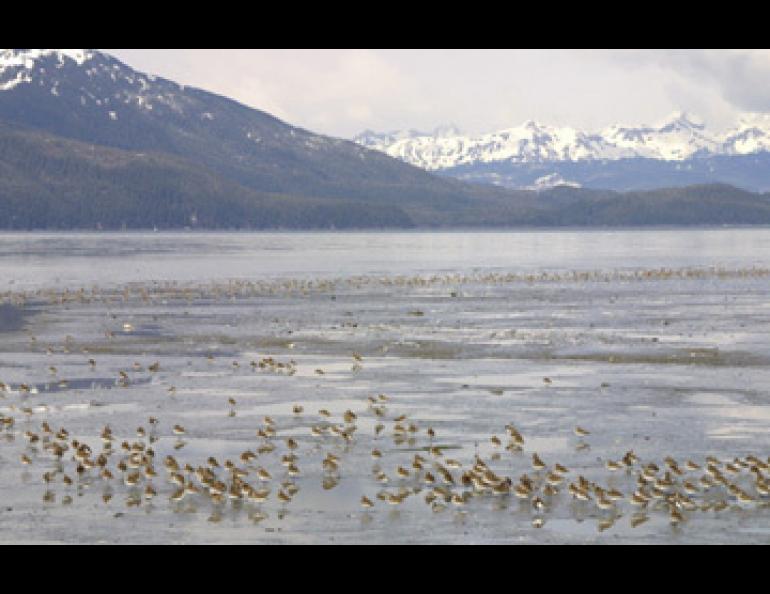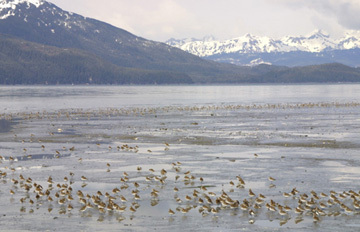
Surrounded by Wings and Feathers on the Copper River Delta
We entered the Powder House bar at 9:51 p.m. and handed our checklist to contest judge Milo Burcham. We sat down, our skin coated with grit accumulated from the beaches, forests and gravel roads of the Copper River Delta during the past 24 hours. Kristen Bartecchi, Lisa Beattie, and I had done our best to see as many species of birds as possible during the Great Cordova Birding Challenge, and it was time to rest.
Since 10 p.m. the night before, we had explored Alaska's onramp for migrating birds, the Copper River Delta. The delta extends for about 70 miles of Alaska coastline and covers 1,000 square miles from Cape St. Elias to Point Whitshed near Cordova.
In this birder's paradise of tidal mud flats, slow-moving sloughs, and mossy rainforests, our team buzzed along the delta in a rented Dodge Caravan. Using the Copper River Highway, we crossed muddy flats that attract more than 80 percent of the world's western sandpiper population and nearly all the Pacific dunlin. More than 5 million shorebirds and 9 million waterfowl visit the Copper River Delta every spring, according to scientists with the U.S. Forest Service in Cordova. Many of the shorebirds stay only a few days, long enough to replenish their fat reserves and move on. Many of the waterfowl stay throughout the breeding season.
The Copper River Delta is an essential stop for many birds entering Alaska. Large mountains and icefields, such as Rhode-Island-size Malaspina Glacier, prevent birds from lingering along Alaska's coast to the east and south until they reach the flatness of the delta, with its milder weather and abundant food. The delta-a swath of mud flats and greenery larger than some countries-serves as a refueling stop for birds continuing west to Prince William Sound and other nesting areas in Alaska.
Western sandpipers are among the many shorebirds that visit the Copper River Delta every spring. Kristen, Lisa, and I encountered thousands of these tiny birds on the salty mud of Hartney Bay near Cordova. The sandpipers, smaller than a tennis ball, skittered along the flats like ants, injecting their bills into the soft mud. Now and then, the birds took wing by the hundreds, flying around the bay and veering in sync like schools of baitfish.
Arriving in the delta from wintering grounds as far south as Peru, western sandpipers may have fasted for days as they migrated north and west before reaching the rich tidal zones of the Copper River Delta. According to the Birder's Handbook, the delta is one of only five sites in North America that support more than one million shorebirds each year. The others are Washington's Gray's Harbor, eastern Canada's Bay of Fundy, Kansas' Cheyenne Bottoms, and the beaches of Delaware Bay in New Jersey and Delaware.
We couldn't count the multitudes of sandpipers we saw at Hartney Bay, but Brina Kessel and the late Pete Isleib detailed what they saw on the delta in Birds of the North Gulf Coast-Prince William Sound Region, Alaska:
"Densities of more than 250,000 shorebirds per square mile fed on the tidal flats of the Copper River Delta in early May, 1964."
We identified 47 different species of birds during our 24 hours of searching, and we missed many more. At the Powder House, as judges for the Great Cordova Birding Challenge counted the results from the four local teams, Kristen, Lisa and I sunk a bit in our chairs: the Purple Sandpipers, the winning team of Craig Reiser and Dedrick Benz, counted 81 species. Two other teams counted 79 and 78 species. In the end, each team member's $20 entry fee went to the Copper River Delta Shorebird Festival.
We left the Powder House in the dark, and then drove to a Forest Service cabin to end our marathon day of birding. As we fell into a deep sleep, thousands of migrants stirred in the woods and flats surrounding us.





